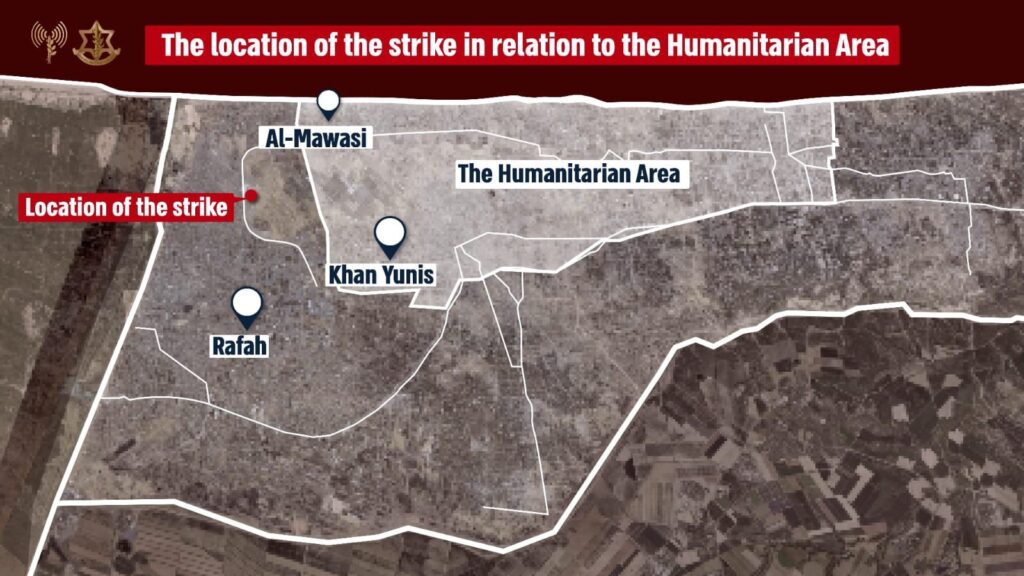FRESH AIR
What we currently know about Rafah’s Tel al-Sultan tragedy
May 28, 2024 | Ahron Shapiro

The target: Two high-level Hamas commanders
In the early morning hours of May 27, 2024 in the West Rafah neighbourhood of Tel al-Sultan, an Israeli air strike successfully targeted two top Hamas officials: Yassin Rabia, and Khaled Nagar. Rabia was Hamas’ chief of staff for its operations in the West Bank while Nagar, according to Israeli media reports, directed shooting attacks and other terrorist activities across the West Bank and was also involved in transferring funds intended for Hamas’ terrorist activities in the Gaza Strip. Both fugitives had been serving life sentences in Israeli prisons for deadly terror offences before being released as part of the deal to free kidnapped IDF soldier Gilad Shalit in 2011. They had returned to Hamas’ ranks, orchestrating terror activity in the West Bank with relative impunity, until Monday, from Hamas-controlled Gaza.
What happened, and what went wrong?
Israel’s Channel 12 evening news reported (translated from the Hebrew) that the attack was carried out according to normal procedures, with targeting protocols and the use of smart bombs, which in similar attacks had generally kept collateral damage small. However, this time, a secondary explosion of some kind occurred. Channel 12’s reporter said:
“An observation drone was sent above the building to make sure that there is no one in the vicinity whom [the IDF] did not want to harm. After all the necessary approvals, two precise bombs were launched towards the building, with small warheads to avoid collateral damage. The two Hamas targets were killed, but for an unknown reason that is now being investigated, a number of tents that were a distance of many tens of metres away caught fire.
“According to the Palestinian Ministry of Health, about 40 civilians, including children, perished [the widely reported number has been since updated to 45 – AS]. The IDF has begun to investigate the incident. Were munitions hidden by Hamas or other incendiary materials that caused the dire result, a secondary explosion on the spot? This is exactly what will be checked, because in previous assassinations conducted in the same way there was no such severe damage.”
The Times of Israel cited one working theory that shrapnel from the attack may have ignited a nearby fuel storage tank – which caused the tents to catch fire.
Attack took place in an active combat zone, not in a designated humanitarian area
Contrary to many media reports, the building housing Rabia and Nagar struck by Israel’s precision drone attack was situated “many tens of meteres” from the tent camps housing Gazan civilians displaced by the war where the fire apparently occurred.
According to the Wall Street Journal, Gazan authorities attempted to argue that IDF leaflets had still indicated that the area where the air strike occurred was not a combat area, but part of the Al-Mawasi humanitarian zone which Israel said would be protected from attacks.
Yet the leaflet they pointed to as evidence did not support this claim.
“Ahmed Al Sufi, the Palestinian mayor of Rafah, cited a leaflet that the Israeli military had issued to residents that said the humanitarian area would extend to a block labeled 2371 where Al Sufi said the strike took place,” the WSJ article stated. A map on the leaflet below the Arabic text, however, didn’t show the block in yellow highlights like the rest of the humanitarian area.
On social media, the IDF released a map clearly showing the separation between where the strike was and the safe zone.
IDF: Precautions were taken to avoid civilian casualties but investigation launched
According to another report by the Times of Israel, the IDF issued a statement that the strike had been carried out based on “intelligence information on the presence of the terrorists in the area,” and that beforehand, it had carried out “many steps to reduce the chance of harming uninvolved [civilians], including aerial surveillance, the use of precision munitions, and additional intelligence information.”
However, following the reports of the civilian casualties, the IDF immediately announced that it would initiate an independent investigation into the incident.
The Channel 12 report added that “The decision that the IDF command investigative team, an unconditionally independent team, will be the one to investigate the incident, was intended to produce transparency, clarity and credibility of the findings.”
The IDF’s Chief Military Advocate Yifat Tomer-Yerushalmi told reporters at a press conference:
“Naturally, in a war of such scope and intensity, difficult events also happen. Some of the events, like last night’s event in Rafah, are very difficult. The details of yesterday’s event are still under review, and we are committed to seeing it through to the end. The IDF regrets any injury to non-involved people during the war.”
Israel PM Binyamin Netanyahu said of the incident: “Despite our efforts not to harm them [Gaza civilians], there was a tragic mishap. We are investigating the incident. For us, it’s a tragedy; for Hamas it’s a strategy.”
A US Administration spokesperson said of the incident, ““Israel has a right to go after Hamas, and we understand this strike killed two senior Hamas terrorists who are responsible for attacks against Israeli civilians, but, as we’ve been clear, Israel must take every precaution possible to protect civilians… We are actively engaging the IDF and partners on the ground to assess what happened.”
This fact sheet will be updated as more information from the investigation becomes available.
Tags: Hamas, IDF, Israel, Palestinians, Rafah
RELATED ARTICLES

‘Optimism’ for Hamas to ‘exile’ their power and create a permanent ceasefire with Israel: Joel Burnie on Sky News

Australian government’s response to Iran-Israel conflict ‘disappointing’: Paul Rubenstein on Sky News

UNRWA feeds the ‘Palestinian delusion’ of no Jewish state: Dr Einat Wilf on Sky News




















